| dc.description.abstract | Knowledge is scarce on the course of psychiatric disorders in adolescence. We aimed to assess changes in the frequency of psychiatric disorders, somatic disorders, pain, and substance use in a clinical psychiatric cohort from adolescence to young adulthood. This study is part of the Health Survey in Department of Children and Youth, St. Olavs Hospital, Norway. At age 13–18 years, 717 (43.5% of eligible) participated in the first study visit (T1) in 2009–2011, 549 were reassessed 3 years later with telephone interview (T2), and 464 had diagnostic evaluation at both time points. Data included: ICD-10 diagnoses (T1), DSM-IV diagnoses (T2), self-reported pain and substance use (T1 and T2). The overall rate of psychiatric disorders decreased (T1 vs. T2: 94.8% vs. 72.2%, p < 0.001); while, an increased rate of anxiety disorders was marked among girls (37.5% vs. 55.9%, p < 0.001), with accompanying raised frequencies of psychiatric comorbidity (14.1% vs. 42.6%, p < 0.001), somatic comorbidity (9.4% vs. 19.5%, p = 0.001), chronic pain (31.6% vs. 49.4%, p < 0.001), smoking, alcohol use and trying illicit drugs. Chronic pain, smoking and trying illicit drugs were associated with persisting psychiatric disorders, with highest risk differences for girls (RD = 25.4%, p = 0.002, RD = 15.6%, p = 0.008, RD = 18.0%, p = 0.001, respectively). Three out of four adolescents still had a psychiatric disorder after 3 years. Unlike boys, girls had an increasing rate of anxiety disorders and comorbidities. Chronic pain, smoking and trying illicit drugs were associated with persisting psychiatric disorders. Despite methodological limitations, these findings emphasize the importance of early targeted intervention for adolescents with psychiatric disorders. | en_US |
| dc.description.localcode | Open Access This article is licensed under a Creative Commons Attribution 4.0 International License, which permits use, sharing, adaptation, distribution and reproduction in any medium or format, as long as you give appropriate credit to the original author(s) and the source, provide a link to the Creative Commons licence, and indicate if changes were made. The images or other third party material in this article are included in the article's Creative Commons licence, unless indicated otherwise in a credit line to the material. If material is not included in the article's Creative Commons licence and your intended use is not permitted by statutory regulation or exceeds the permitted use, you will need to obtain permission directly from the copyright holder. | en_US |

